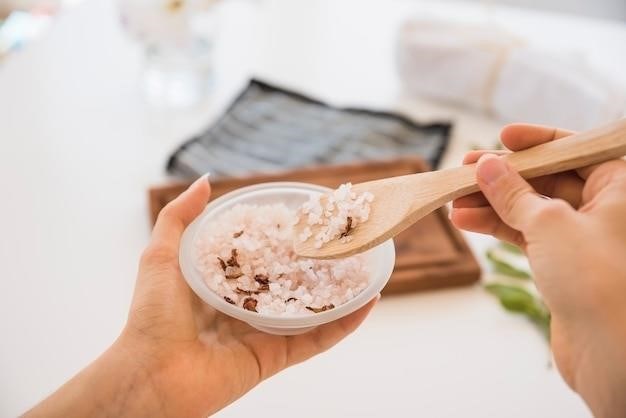manual exfoliation
Manual Exfoliation⁚ A Guide to Smoother, Brighter Skin
Manual exfoliation, also known as physical exfoliation, is a skincare technique that involves using a tool, liquid, gel, or scrub to manually remove dead skin cells. This method can be achieved with skincare products, in-office treatments, or tools, and aims to reveal brighter, smoother skin underneath.
What is Manual Exfoliation?
Manual exfoliation, also known as physical exfoliation, is a skincare technique that involves using a tool, liquid, gel, or scrub to manually remove dead skin cells from the surface of the skin. This method can be achieved with skincare products, in-office treatments, or tools. The goal of manual exfoliation is to remove the outermost layer of dead skin cells, revealing the fresh, healthy skin underneath. This process helps to improve skin texture, reduce the appearance of wrinkles and fine lines, and promote a brighter, more even skin tone.
Manual exfoliants come in a variety of forms, including scrubs, brushes, sponges, and even tools like dermaplaning blades. These products are designed to physically remove dead skin cells by gently rubbing or scrubbing the skin. It’s important to choose a manual exfoliant that is appropriate for your skin type and to use it gently to avoid irritation or damage to the skin.
When using a manual exfoliant, it’s essential to be gentle. Harsh scrubbing can damage the skin and lead to irritation, redness, and even breakouts. Always apply the product in a circular motion, and be sure to rinse it off thoroughly afterwards.
Benefits of Manual Exfoliation
Manual exfoliation offers a variety of benefits for your skin, contributing to a healthier and more radiant complexion. One of the primary advantages is the removal of dead skin cells, which can accumulate and lead to a dull, uneven skin tone. By sloughing off this layer, manual exfoliation reveals the brighter, smoother skin underneath, promoting a more youthful appearance. This process also helps to unclog pores, preventing the formation of blackheads and whiteheads, and ultimately reducing the risk of acne breakouts.
Furthermore, manual exfoliation can stimulate blood circulation to the skin’s surface, leading to a healthier, more vibrant glow. Increased blood flow delivers essential nutrients and oxygen to the skin cells, promoting cell regeneration and contributing to a more youthful appearance. Regular manual exfoliation can also improve the absorption of skincare products, allowing them to penetrate deeper and work more effectively. By removing the barrier of dead skin cells, the active ingredients in your skincare products can reach the underlying layers of skin, maximizing their efficacy.
However, it is crucial to remember that over-exfoliation can have detrimental effects. Excessive scrubbing can damage the skin’s protective barrier, leading to irritation, redness, and sensitivity. It is essential to use manual exfoliants sparingly and to choose products that are appropriate for your skin type.
Types of Manual Exfoliants
Manual exfoliants come in a variety of forms, each offering a different approach to removing dead skin cells. One common type is scrubs, which contain abrasive particles like sugar, salt, or ground nutshells. These particles physically rub against the skin, sloughing off dead cells. Another option is masks, which often contain ingredients like clay or charcoal that bind to dirt and impurities while gently exfoliating the skin. Sponges and brushes are also popular tools for manual exfoliation. These tools are designed to gently massage the skin and remove dead cells.
For a more targeted approach, exfoliating gloves are available, which feature textured surfaces that can be used to scrub the skin. These gloves can be particularly effective for removing dead skin from areas like the elbows and knees. Another option for manual exfoliation is dermaplaning, a professional treatment that involves using a surgical blade to gently remove the top layer of dead skin cells and peach fuzz. This treatment can result in smoother, brighter skin and improved product absorption.
It’s important to note that not all manual exfoliants are created equal. Some are more abrasive than others, and it’s crucial to choose a product that’s appropriate for your skin type and sensitivity. For those with sensitive skin, gentler options like a soft washcloth or a brush with soft bristles may be preferable.
How to Choose the Right Manual Exfoliant
Selecting the right manual exfoliant for your skin is crucial to avoid irritation and achieve optimal results. The key is to consider your skin type and sensitivity. For those with dry or sensitive skin, opting for a gentle exfoliant with fine, smooth particles is recommended. These options are less likely to cause irritation or dryness. Look for ingredients like sugar, finely ground almonds, or rice flour, which are gentler on delicate skin.

If you have oily or acne-prone skin, you can generally tolerate more abrasive exfoliants. Look for scrubs containing ingredients like salt, coffee grounds, or walnut shells, which can effectively remove excess oil and impurities. However, even with oily skin, it’s essential to avoid over-exfoliation, as this can lead to inflammation and breakouts.
Consider your skin’s condition as well. If you have active acne, avoid using scrubs with harsh particles that can irritate inflamed areas. Instead, opt for a gentle exfoliating mask or a soft washcloth to remove dead skin cells without exacerbating breakouts. Always patch test any new exfoliant on a small area of your skin before applying it to your entire face. This will help you determine if you have any adverse reactions.
How to Use Manual Exfoliants
Proper application of manual exfoliants is essential for effective results and avoiding irritation. Start by cleansing your skin thoroughly with a gentle cleanser to remove any makeup, dirt, or oil. This ensures that the exfoliant can reach the surface of your skin effectively. Apply a small amount of the exfoliant to your fingertips and massage it gently in circular motions over your skin. Avoid rubbing too hard, as this can damage the skin and lead to irritation.
Focus on areas where dead skin tends to accumulate, such as the nose, forehead, chin, and cheeks. Pay special attention to the T-zone, as this area is often prone to oil buildup and clogged pores. Once you’ve massaged the exfoliant into your skin, rinse it off thoroughly with lukewarm water. Be sure to remove all traces of the exfoliant to prevent clogged pores and irritation.
After exfoliating, follow up with your regular skincare routine, which may include a toner, serum, moisturizer, and sunscreen. Exfoliation can make your skin more sensitive to the sun, so always apply sunscreen with an SPF of 30 or higher, even on cloudy days.
Frequency of Manual Exfoliation
The frequency of manual exfoliation depends on your skin type and sensitivity. It’s important to find a balance that works for your skin without overdoing it. For most people, exfoliating two to three times per week is a good starting point. However, individuals with sensitive or dry skin may need to exfoliate less frequently, perhaps once a week or even less. On the other hand, those with oily skin may benefit from exfoliating more often, up to three or four times per week.
It’s crucial to listen to your skin and adjust the frequency as needed. If you notice any signs of irritation, such as redness, dryness, or flaking, reduce the frequency of exfoliation or switch to a gentler exfoliant. If you’re unsure about how often to exfoliate, it’s always best to consult with a dermatologist or skincare professional for personalized advice.
Remember, the goal is to promote healthy skin turnover without causing damage or irritation. By finding the right frequency and exfoliant for your skin, you can enjoy the benefits of a brighter, smoother complexion.
Precautions and Potential Side Effects
While manual exfoliation can be beneficial for many, it’s crucial to exercise caution to avoid potential side effects. Over-exfoliating can lead to irritation, redness, dryness, and even damage to the skin’s protective barrier. It’s important to choose the right exfoliant for your skin type and sensitivity, and to use it gently. Avoid harsh scrubs or tools that can scratch or tear the skin.
Another potential side effect of manual exfoliation is increased sensitivity to the sun. Exfoliation removes the top layer of skin, which helps protect against UV damage. After exfoliating, it’s essential to apply sunscreen with an SPF of 30 or higher, even on cloudy days.
If you have any existing skin conditions, such as acne, eczema, or rosacea, it’s best to consult with a dermatologist before using any type of exfoliant. They can help you determine the safest and most effective approach for your individual needs. Remember, listening to your skin and taking precautions is key to enjoying the benefits of manual exfoliation without experiencing any negative side effects.
Manual Exfoliation for Different Skin Types
The approach to manual exfoliation should be tailored to your specific skin type to maximize benefits and minimize irritation. Individuals with dry or sensitive skin should opt for a gentle chemical exfoliator or physically exfoliate with a washcloth or soft brush. Harsh scrubs can exacerbate dryness and sensitivity.
On the other hand, oily skin individuals can tolerate more aggressive chemical exfoliators or stick with physical exfoliation, as their skin is less prone to dryness and irritation. For acne-prone skin, a gentle approach is key. Choose exfoliants with salicylic acid or glycolic acid to help unclog pores and prevent breakouts.
Regardless of your skin type, it’s crucial to listen to your skin’s cues. If you experience any redness, burning, or discomfort, discontinue use and consult a dermatologist. Remember, the goal of manual exfoliation is to improve skin health, not to cause irritation or damage.
Post-Exfoliation Skincare Routine
After manual exfoliation, your skin is more susceptible to irritation and dryness. Therefore, it’s crucial to follow up with a soothing and hydrating skincare routine. Start by gently cleansing your face with a mild cleanser, avoiding harsh ingredients that can further irritate the skin.
Next, apply a hydrating toner to restore the skin’s pH balance and prepare it for the next steps. Follow with a serum packed with antioxidants to combat free radical damage and promote cell regeneration. Finally, seal in all the goodness with a rich moisturizer that suits your skin type.
For extra protection, especially after a more aggressive exfoliation, consider applying a layer of sunscreen with an SPF of 30 or higher to shield your skin from harmful UV rays. By following a post-exfoliation skincare routine, you can help your skin recover, retain moisture, and achieve optimal results.
